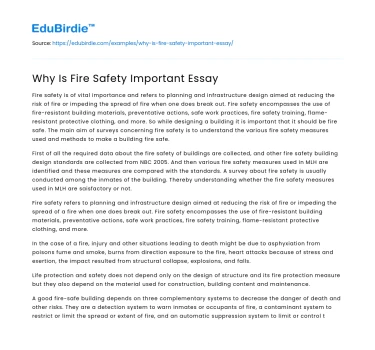Fire safety is of vital importance and refers to planning and infrastructure design aimed at reducing the risk of fire or impeding the spread of fire when one does break out. Fire safety encompasses the use of fire-resistant building materials, preventative actions, safe work practices, fire safety training, flame-resistant protective clothing, and more. So while designing a building it is important that it should be fire safe. The main aim of surveys concerning fire safety is to understand the various fire safety measures used and methods to make a building fire safe.
First of all the required data about the fire safety of buildings are collected, and other fire safety building design standards are collected from NBC 2005. And then various fire safety measures used in MLH are identified and these measures are compared with the standards. A survey about fire safety is usually conducted among the inmates of the building. Thereby understanding whether the fire safety measures used in MLH are saisfactory or not.
Save your time!
We can take care of your essay
- Proper editing and formatting
- Free revision, title page, and bibliography
- Flexible prices and money-back guarantee
Fire safety refers to planning and infrastructure design aimed at reducing the risk of fire or impeding the spread of a fire when one does break out. Fire safety encompasses the use of fire-resistant building materials, preventative actions, safe work practices, fire safety training, flame-resistant protective clothing, and more.
In the case of a fire, injury and other situations leading to death might be due to asphyxiation from poisons fume and smoke, burns from direction exposure to the fire, heart attacks because of stress and exertion, the impact resulted from structural collapse, explosions, and falls.
Life protection and safety does not depend only on the design of structure and its fire protection measure but they also depend on the material used for construction, building content and maintenance.
A good fire-safe building depends on three complementary systems to decrease the danger of death and other risks. They are a detection system to warn inmates or occupants of fire, a contaminant system to restrict or limit the spread or extent of fire, and an automatic suppression system to limit or control the fire until it can be extinguished.






 Stuck on your essay?
Stuck on your essay?

